9. LA SUCCESSIONE GIURASSICA DI VALDORBIA: TREND DEPOSIZIONALI EVIDENZIATI DA SEDIMENTOLOGIA, MICROPALEONTOLOGIA E GEOCHIMICA
Depositional trends in the Valdorbia Section (Central Italy) during the Early Jurassic, as revealed by micropaleontology, sedimentology and geochemistry.
Collaboration: M. NOCCHI, F.VENTURI & G.CHIAVINI (Perugia), M. ORTEGA-HUERTAS (University of Granada), I. PALOMO (Granada), F. MARTINEZ (Granada).
MONACO P., NOCCHI M., ORTEGA-HUERTAS M., PALOMO I, MARTINEZ F. & CHIAVINI G. (1994) - Depositional trends in the Valdorbia section (Central Italy) during the Early Jurassic, as revealed by micropaleontology, sedimentology and geochemistry. Eclogae geol. Helv., 87 (1): 157-223.
© and permission of all colour photographs, text and charts by P. Monaco
In the Umbria-Marche basin open marine sediments are well exposed in this very important stratigraphic section for the Jurassic, the Valdorbia section (ENE of Gubbio, Central Italy). Probably this section is the most important of those of Central Apennnes for the Jurassic. The time interval considered here is from the Carixian to the Lower Aalenian. The depositional units, already dated by means of ammonites and calcareous nannofossils, are (Fig.1): limestones and cherty limestones, Pleinsbachian in age ("Corniola" = COR); marls of Lower - Middle Toarcian age ("Marne del Monte Serrone" = MS), including black shales in the Tenuicostatum Zone; reddish nodular calcareous marls and limestones, Middle Toarcian to Lower Aalenian in age, which constitute the "Rosso Ammonitico Umbro-Marchigiano" (= RAUM); and bivalve-bearing cherty limestones, Aalenian in age ("Calcari a Posidonia" = CP). Micropaleontological, sedimentological, trace fossil and geochemical-mineralogical analyses have been carried out. The microfossil study has revealed changes in the microforaminiferal assemblages, corresponding to changes in both oxygen conditions and depth of the sea floor: Miliolina, Textulariina and Lagenina are common in the Carixian; Textulariina and Lagenina in the Domerian and Lagenina, Spirillinina in the Toarcian/Aalenian (Figs.2 to 5). Opportunistic small species bloom in the most anoxic levels of the black shales.
The sedimentological study reveals two peaks in the detrital sedimentation. The first - probably connected with local tectonics (without excluding sea-level changes)- is found in the interval from the Carixian to the lower part of the Lower Toarcian. Metre-scale cycles of fine-grained calcareous turbidites, due to low-density flows, evolve gradually into coarse-grained, metre-thick turbidites often amalgamated and containing reworked skeletal grains of a carbonate platform environment, and gravity flow deposits. The second peak occurs in the Middle-Upper Toarcian. Fine-grained turbidites are overlain by hummocky cross-stratified (HCS) deposits and winnowed beds (WB), with large and pervasive bioturbation. The vertical transition from turbidites to sharp-based HCS deposits and WB is probably indicative of a general regressive trend and of a depositional environment above major storm wave base. This trend has also been indicated from the microfossil study.
Geochemical analysis of the Lower Toarcian (Tenuicostatum Zone) has revealed strong positive anomalies in Ba, V, Cr, Ni, Co, Cu, Zn, As, Sb and Pb, elements which are characteristic of black shale episodes (Fig.3). Weaker positive anomalies occur in similar sediments of the lower part of MS Formation, while such positive anomalies are absent in the largely bioturbated sediments deposited below (COR) and above (RAUM) the MS.
Depositional trends related to tectonic-eustatic variations in the depositional environment (Fig.5) are suggested on the basis of information provided by the study of the Valdorbia Section and of other Umbria-Marche sections.
Sedimenti pelagici del Giurassico sono ben esposti lungo l'importante sezione Giurassica di Valdorbia (ENE di Gubbio, Appennino Centrale). Tale sezione è ben nota in quanto è indicativa della sedimentazione giurassica di mare aperto che ha sostituito, nel Lias inferiore dell'area Umbro-Marchigiana, la sedimentazione tipica di una piattaforma carbonatica (Calcare Massiccio). Le seguenti unità litostratigrafiche, già datate in base alle ammoniti e ai nannofossili calcarei, sono state qui studiate mediante analisi micropaleontologica, sedimentologica, delle tracce fossili e geochimico-mineralogica (Fig.1): l'unità calcareo-silicea della "Corniola" (COR, Pleinsbachiano); la Formazione marnosa delle "Marne del "Monte Serrone" (MS,Toarciano inferiore-medio) con episodi anossici ("black shales") del Toarciano inferiore; l'unità calcareo-nodulare del "Rosso Ammonitico Umbro-Marchigiano" (RAUM,Toarciano medio - Aaleniano inferiore); e infine l'unità calcarea dei "Calcari a Posidonia" (CP, Aaleniano s.l.).
L'esame dei microfossili ha rilevato variazioni nelle associazioni a microforaminiferi, corrispondenti a cambiamenti nel grado di ossigenazione e profondità del fondo marino. Essi sono rappresentati da Miliolina, Textulariina e Lagenina nel Carixiano,da Textulariina e Lagenina nel Domeriano e da Lagenina e Spirillinina nel Toarciano ed Aaleniano (Figg.2 -5). Nei livelli a black shales le associazioni a foraminiferi sono caratterizzate da forme opportunistiche. I resti di macroinvertebrati sono sempre comuni, ad eccezione nel Toarciano inferiore.
Lo studio sedimentologico ha evidenziato essenzialmente due acmi di sedimentazione detritica: il primo, tra il Carixiano ed il Toarciano inferiore, legato prevalentemente a tettonica locale senza escludere variazioni eustatiche; il secondo, legato probabilmente a regressione tettonico/eustatica, tra il Toarciano inferiore/medio e la base dell'Aaleniano. Nel primo acme si hanno calcisiltiti torbiditiche a laminazioni piano-parallele, riferibili a flussi a bassa densità, a cui seguono nel Toarciano inferiore calcareniti/ruditi torbiditiche amalgamate, legate a flussi di alta densità, e depositi gravitativi. Il secondo acme è rappresentato per lo più da calcareniti ad stratificazione incrociata "hummocky" (HCS) nel Toarciano medio-superiore, ed infine a livelli selezionati "granulo sostenuti" (WB) nel Toarciano superiore. Questo secondo trend indica probabilmente una diminuzione di profondità del bacino, da sotto la base d'onda di tempesta (torbiditi) a intorno o poco sotto essa (100-130 m all'incirca di profondità), con aumento anche del grado di ossigenazione del fondo, dimostrato dalla bioturbazione pervasiva.
L'analisi mineralogica delle argille ha messo in evidenza una certa uniformità negli apporti argillosi del Toarciano, mentre quella geochimica ha permesso di riconoscere nelle MS del Toarciano inferiore (Zona a Tenuicostatum) forti anomalie positive in Ba, V, Cr, Ni, Co, Cu, Zn, As, Sb e Pb in corrispondenza dei black shales (Fig.3) e di simili anomalie più deboli nei sedimenti argillosi immediatamente sottostanti. Queste anomalie sono assenti nei sedimenti della COR e del RAUM che si presentano anche decisamente bioturbati (tracce fossili grandi e penetrative), testimoniando un buon grado di ossigenazione sul fondo marino.
L'approccio interdisciplinare ha permesso di individuare una tendenza all'approfondimento del fondo marino in corrispondenza del Toarciano inferiore (Zona a Tenuicostatum) ed una tendenza alla diminuzione di profondità in corrispondenza della facies calcareo-nodulare del RAUM nel Toarciano medio-superiore (Fig.5). Vengono perciò suggerite variazioni tettonico-eustatiche nel bacino di sedimentazione, tenendo in considerazione anche informazioni derivate dallo studio di altre aree del bacino Umbro-Marchigiano.
The Valdorbia section
Prof. F.Venturi (Perugia)
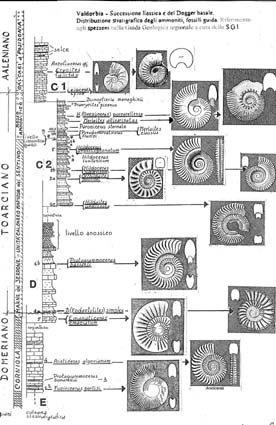
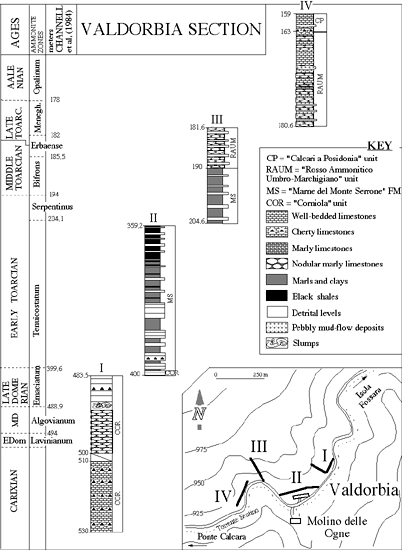
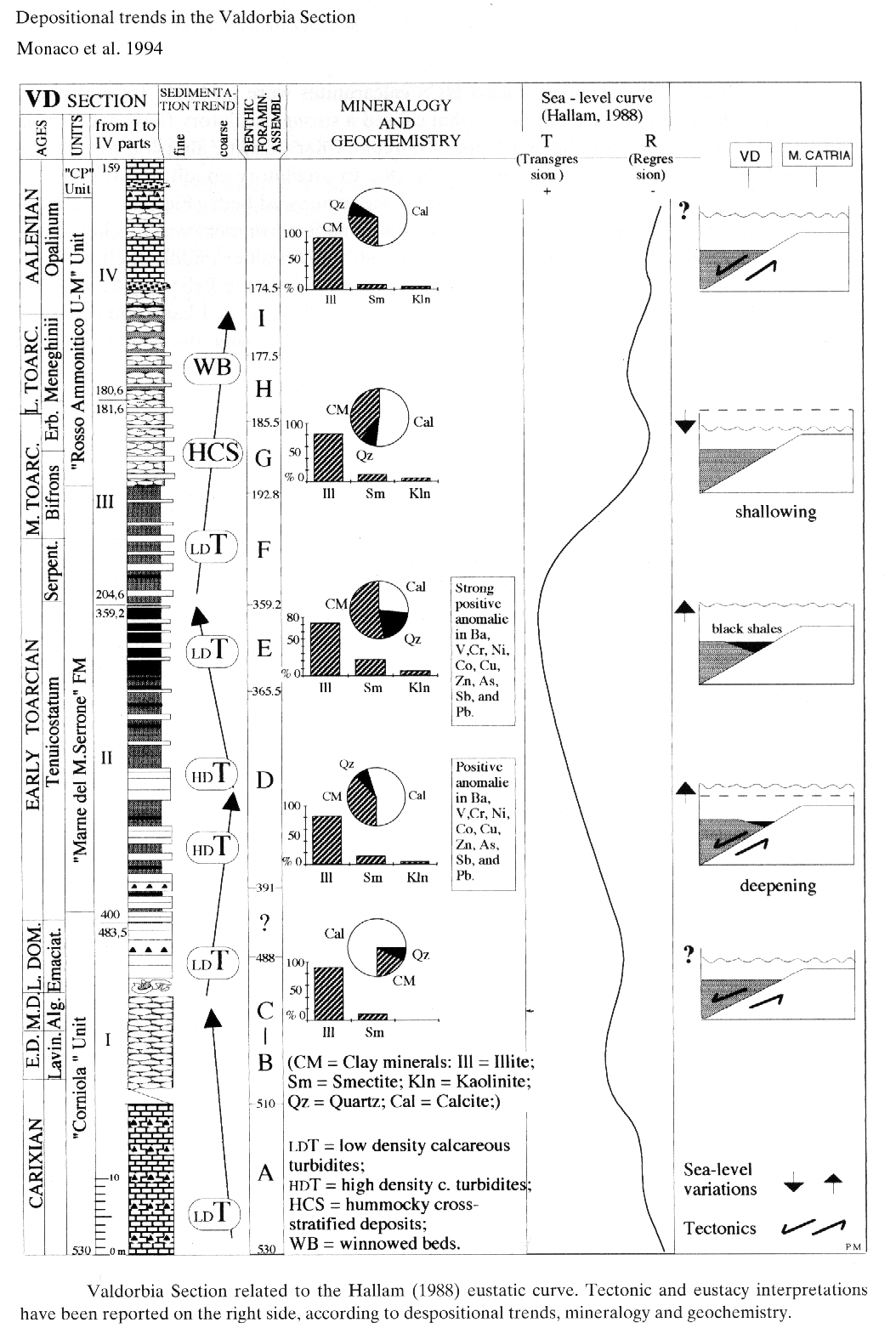
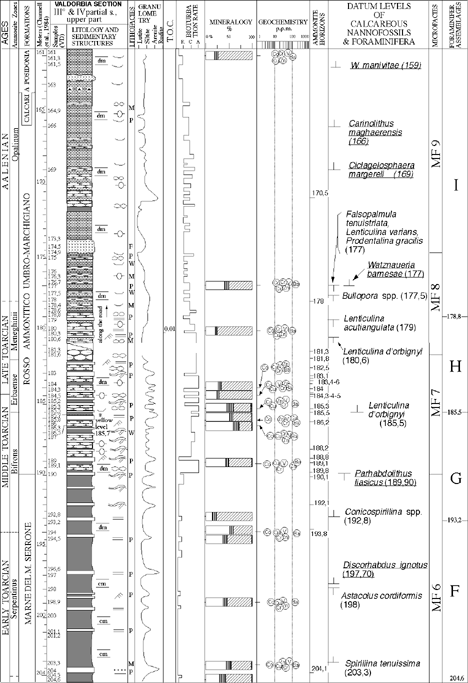
sections III-IV (click to enlarge)
depositional trends (click to enlarge)
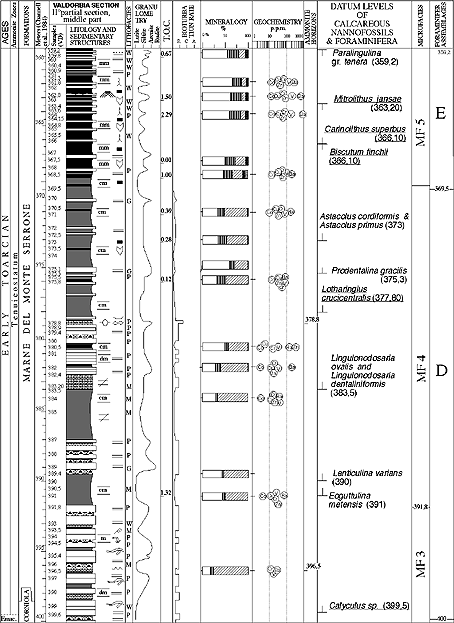
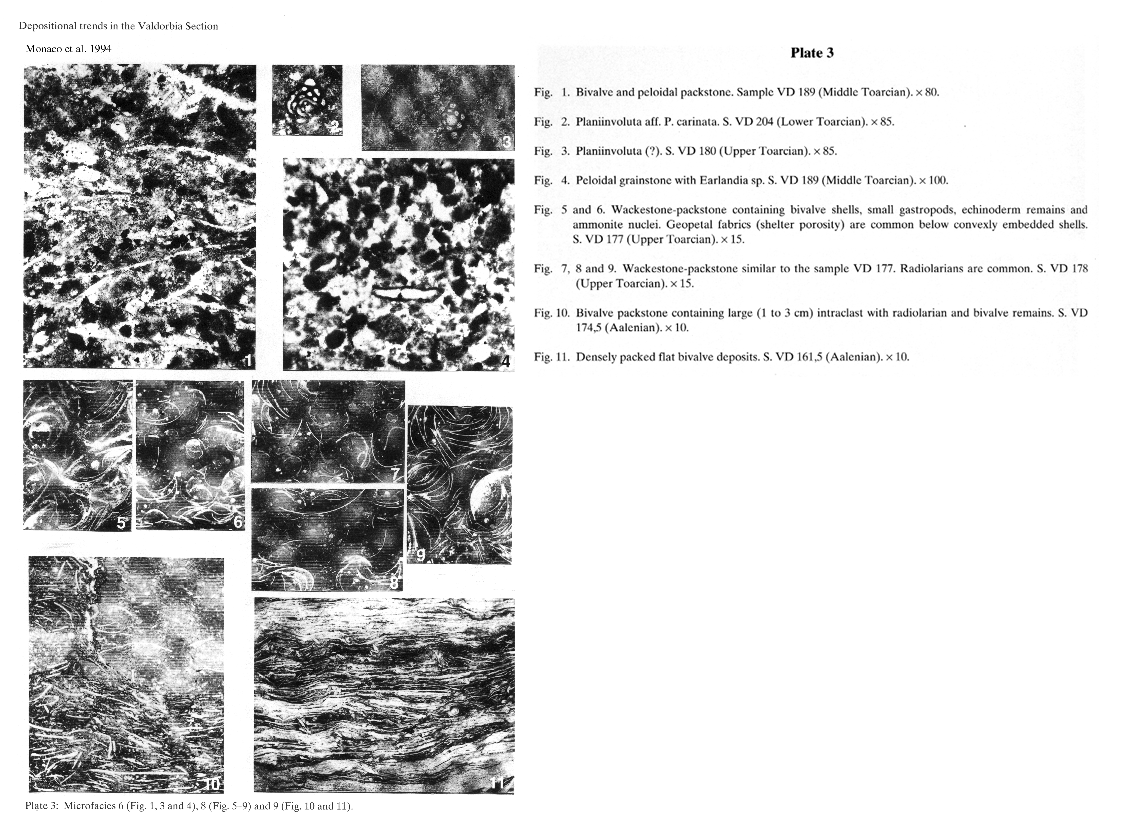
section II (click to enlarge)
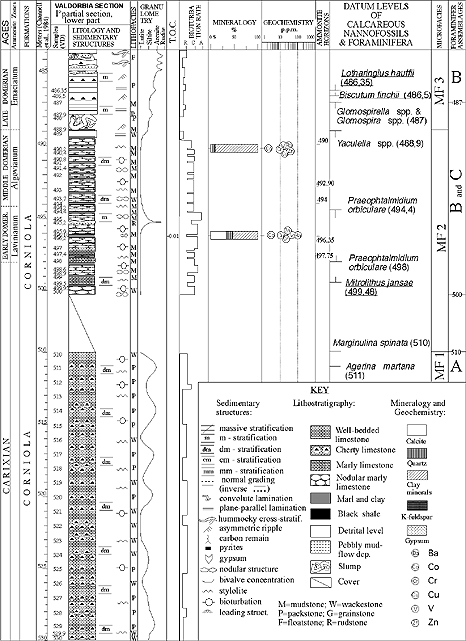
microfacies plate (click to enlarge)
section I (click to enlarge)
In the Valdorbia different trends are recognized in the sedimentological, microfaunal and geochemical studies (Figg.1 - 5):
• a) The microfaunal assemblages indicate a deepening trend from Carixian - Lower Domerian to the lower part of the Toarcian (base of Tenuicostatum Zone), where the microfaunal assemblage and the presence of the illite-smectite association give indications of the maximum depth (and reworking) reached by the basin at the beginning of the Toarcian. The absence of kaolinite supports the hypothesis of a relatively deep marine environment.
• b) The major factor affecting the microfauna within the Tenuicostatum Zone is a lack of oxygen which prevents recognition of any depositional trend. A fining-upward trend is recognizable, by means of sedimentological analysis, from the Tenuicostatum to the Serpentinus Zones. Coarse-grained, high-density calcarenitic turbidites were overlain by thin, fine-grained planar-bedded calcisiltitic turbidites during the maximum black shale deposition (see Fig. 5). The persistent, relative deep conditions during the black shale deposition is indicated by the greater abundance of smectite and the continuing scarcity of kaolinite and by the ornate burrow-systems. As mentioned, it is clear that, together with the continuity of a deep depositional environment, confined areas of restricted water circulation also existed in which the black shales were deposited.
• c) After the period of poorly ventilated sea-bottom conditions (Serpentinus Zone), the microfaunal assemblages indicate a slow improvement in the oxygenation level. A relative shallowing began from the lower part of the Bifrons Zone and reached a maximum at the end of the Toarcian (Meneghinii Zone), as shown by the continuous reduction in smectite content. An abrupt change in the environmental conditions is evident at the Bifrons/Erbaense zonal boundary. From the sedimentological point of view a shallowing-upward trend from the Serpentinus Zone to the the upper part of the Toarcian (Meneghinii Zone) is observed. Planar-bedded calcisiltitic turbidites are overlain by sharp-based hummocky cross-bedded HCS calcarenites and, finally, by winnowed beds (Figg. 1 - 5). The sharp-based HCS calcarenites were probably formed under very rare, unusually stormy conditions that caused a strong oscillatory flow regime near the bottom during the Middle and Upper Toarcian. Characteristic abrasion surfaces on some benthic foraminiferal tests seem to be due to oscillatory conditions at the sediment/water interface during the deposition of the winnowed beds (Fig.4). The minimum depth and sedimentation rate of the depositional environment was reached in the upper part of the Toarcian and corresponds roughly to an outer/middle shelf environment, near the major storm wave base (Figg. 1 - 5). Moreover in the Erbaense-Meneghinii Zones the succession is strongly condensed - testified by repeated hardgrounds and firmgrounds - and represented by sediments only 7,5 m thick, in comparison with the Tenuicostatum-Bifrons Zones where deposits 60m thick occur.
• CENTAMORE, E., CHIOCCHINI, M., DEIANA, G., MICARELLI, A. & PIERUCCINI, V. 1969: Considerazioni preliminari su alcune serie mesozoiche dell'Appennino Umbro-Marchigiano. Mem. Soc. Geol. It. 8 (3), 237-263.
• CENTAMORE, Chiocchini, M., Deiana, G.,Micarelli, A. & Pieruccini, U. 1971: Contributo alla conoscenza del Giurassico dell'Appenino umbro-marchigiano. Studi Geol. Camerti 1, 7- 89.
• CHANNELL, J.E.T., LOWRIE, W., PIALLI, P. & VENTURI, F. 1984: Jurassic magnetic stratigraphy from Umbrian (Italian) land sections. Earth and Planetary Science Letters, Elsevier Sc. Publ. 309-325.
• COLACICCHI R., NOCCHI M., PARISI G., MONACO P., BALDANZA A., CRESTA, S. & PALLINI, G. (1988) - Paleoenvironmental analysis from Lias to Malm (Corniola to Maiolica Formations) in the Umbria-Marche basin, Central Italy (preliminary report). In: R. B. ROCHA &. A. F. SOARES (Eds.), 2nd Int. Symp. on Jurassic Stratigraphy , Lisboa, Sept. 1987, 2: 717-728.
• CONTI M.A. & CRESTA S. (1982) - Considerazioni stratigrafiche e paleontologiche sui "livelli a Posidonia" (Auct.) dell'Appennino Umbro-Marchigiano. Paleontologia Stratigrafica ed Evoluzione, Quaderno n°2: 73-80.
• CONTI M.A. & MONARI M. (1992) - Thin shelled bivalves from the Jurassic Rosso Ammonitico and Calcari a Posidonia Formations of the Umbria-Marche Apennine (Central Italy). Paleopelagos, 2: 192-213.
• CRESTA S., CECCA F., SANTANTONIO M., PALLINI G., BRÖNNIMANN P., BALDANZA A., COLACICCHI R., MONACO P., NOCCHI M., PARISI G. & VENTURI F. (1988). Stratigraphic correlations in the Jurassic of the Umbria-Marche Apennines (Central Italy). In: R. B. ROCHA &. A. F. SOARES (Eds.), 2nd Int. Symp. on Jurassic Stratigraphy Lisboa, Sept. 1987, 2: 729-744.
• EINSELE G. & RICKEN W. (1991) - Limestone-Marl alternations - an Overview. In: W. R. G. EINSELE, W. RICKEN & A. SEILACHER (Eds.), Cycles and Events in Stratigraphy,. Berlin, Heidelberg, New York, Springer Verlag: 23-47.
• EINSELE G., RICKEN W. & SEILACHER A. (1991) - Cycles and Events in Stratigraphy - basic concepts and terms. In: W. R. G. EINSELE, W. RICKEN & A. SEILACHER (Eds.), Cycles and Events in Stratigraphy, Berlin, Heidelberg, New York, Springer Verlag: 1-19.
• EINSELE G. & SEILACHER A. (Eds.). (1982) - Cyclic and Event stratification. Berlin, Heidelberg, New York, Springer Verlag: pp. 536.
• ELMI S. 1981a: Classification typologique et genetique des Ammonitico-Rosso et des facies noduleux ou grumuleux: essai de synthese. In: Rosso Ammonitico Symposium Proc. (Ed. by A. Farinacci & S. Elmi), Ediz. Tecnoscienza, Roma 233-249.
• ELMI 1981b: Sedimentation rythmique et organisation sequentielle dans les Ammonitico-Rosso et les facies associes du Jurassique de la Mediterranee occidentale. Interpretation des grumeaux et des nodules. In: Rosso Ammonitico Symposium Prooc. (Ed. by A Farinacci & S. Elmi) Ediz. Tecnoscienza, Roma 251-300.
• KÄLIN O., PATACCA E. & RENZ, O. (1979) - Jurassic pelagic deposits from Southeastern Tuscany; aspects of sedimentation and new biostratigraphic data. Eclogae Geol. Helv., 72 (3): 715-762.
• NINI C., NOCCHI M. & VENTURI F. (1996). The Toarcian marly-calcareous succession in the M.Martani area (Northern Apennines): lithostratigraphy, biostratigraphy, paleoecology and effects of Tethysian events on the depositional environment. Boll. Soc. Paleont. It., 35 (3), 1996: 281-319.
• VENTURI F., FERRI R. (2001) - Ammoniti Liassici dell'Appennino centrale. Tibergraph, Città di Castello, 268 pp.
• VENTURI F., ROSSI S. (2003) - Subasio, origine e vicende di un Monte Appenninico. Porzi Editore, 126 pp.